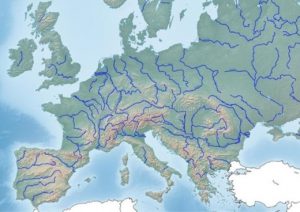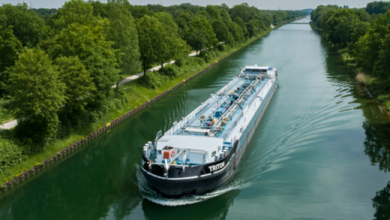Whose regulations in inland shipping?

As each car is required by law to hold a licence plate to be allowed on the streets, a vessel must be registered in a state. However, instead of a licence plate, vessels show their adherence to a state by way of their flag: this is what lawyers call flag state jurisdiction. From a public law perspective, the state under whose flag a vessel is sailing, and consequently the place of registration, is responsible for safety and security aspects related to the vessel’s navigation. However, this is not always the case as more stringent requirements may be issued by a coastal state in whose territorial waters a ship is sailing. In this case, the laws imposed by the coastal state enjoy predominance over those imposed by the flag state jurisdiction (sometimes leading to conflicting rules or situations in which the law is not clear, however, this is another topic…).

Image 1: A state does not need to be a coastal state to be a flag state. Source: https://www.armateursdefrance.org
In maritime shipping, the International Maritime Organisation (IMO) ensures that shipowners cannot cut costs and compromise on safety, security and environmental protection in case of lower standards under the flag state jurisdiction. The IMO can be regarded as the main public regulator in maritime shipping. Its primary role is to create a level-playing field by issuing regulations that its member flag states must adhere to and enforce upon all ships flying their flag. By this, the IMO also achieves high uniform standards and regulations applicable to maritime shipping. Another critical aspect of vessel registration in maritime shipping is that when a vessel enters international waters (i.e. waters over which no state has sovereignty), the laws solely applicable will be that of the flag state jurisdiction.

Image 2: Flag of the United Nations’ specialised agency for the safety and security of shipping and the prevention of marine and atmospheric pollution by ships, the International Maritime Organisation (IMO). Source: https://prosertek.com
The situation in inland shipping is slightly different. First, there is always a state with territorial authority over the geographical space in which a vessel is navigating. Those states may issue different safety requirements. To ensure clarity as to the laws and standards applicable, the state in which the inland vessel is registered is also responsible for the relevant safety standards. Within the European Union (EU), following its “Single Market” strategy (i.e. free movement of goods, services, capital and persons), there is a mutual recognition of safety certificates issued amongst Member States. This means that national safety rules for inland vessels are harmonised through EU law. Another system to harmonise rules of inland waterway is that riparian states (i.e. states having access to the same river) form an alliance and mandate a commission to issue the safety regulations applicable to all riparian states sharing access to the same river. In Europe we have several of such so-called river commissions.

Image 3: Europe’s impressive inland waterway network. Source: https://www.dreamstime.com
In contrast to maritime shipping where the IMO presents the single main regulator, several different regulators issue binding and non-binding rules and regulations in inland shipping. Amongst these are the European Union, the United Nations Economic Commission for Europe (UNECE), different river commissions and national authorities. This fragmented regulatory landscape results in many different regulations, policy documents, recommendations, etc. and is one of the main reasons why the regulatory work achieved so far on regulating autonomous inland shipping seems a rather slow process…
See for more information: https://www.imo.org/
An article by Sophie Orzechowski.
Reference
- Tournaye C, ‘Aspects of Vessel Registration in Inland Shipping’ in: Festschrift Resi Hacksteiner, A Voyage Through the Law of Inland Shipping (2019) Eleven Publishing, pp. 327-347





